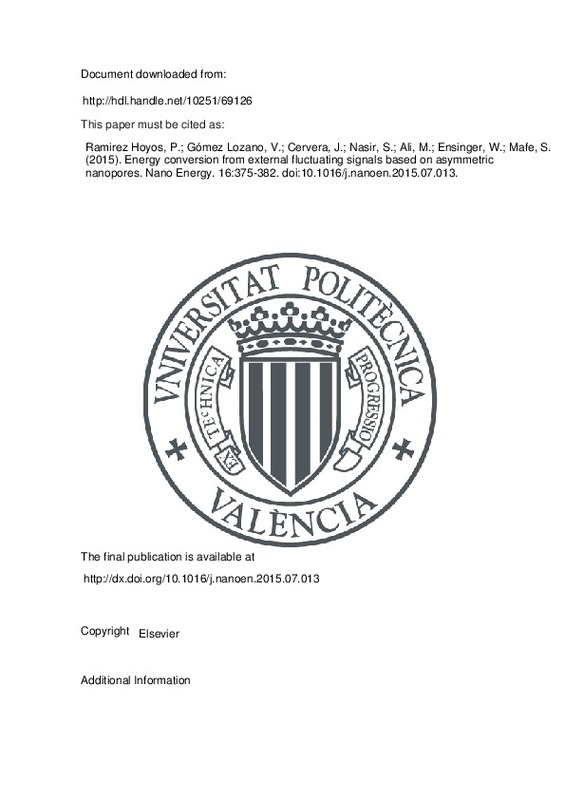JavaScript is disabled for your browser. Some features of this site may not work without it.
Buscar en RiuNet
Listar
Mi cuenta
Estadísticas
Ayuda RiuNet
Admin. UPV
Energy conversion from external fluctuating signals based on asymmetric nanopores
Mostrar el registro sencillo del ítem
Ficheros en el ítem
| dc.contributor.author | Ramirez Hoyos, Patricio
|
es_ES |
| dc.contributor.author | Gómez Lozano, Vicente
|
es_ES |
| dc.contributor.author | Cervera, Javier
|
es_ES |
| dc.contributor.author | Nasir, Saima
|
es_ES |
| dc.contributor.author | Ali, Mubarak
|
es_ES |
| dc.contributor.author | Ensinger, Wolfgang
|
es_ES |
| dc.contributor.author | Mafe, Salvador
|
es_ES |
| dc.date.accessioned | 2016-09-08T14:06:42Z | |
| dc.date.available | 2016-09-08T14:06:42Z | |
| dc.date.issued | 2015-09 | |
| dc.identifier.issn | 2211-2855 | |
| dc.identifier.uri | http://hdl.handle.net/10251/69126 | |
| dc.description.abstract | Electrical transduction from fluctuating external signals is central to energy conversion based on nanoscale electrochemical devices and bioelectronics interfaces. We demonstrate theoretically and experimentally a significant energy transduction from white noise signals using the electrical rectification of asymmetric nanopores in polymeric membranes immersed in aqueous electrolyte solutions. Load capacitor voltages of the order of 1 V are obtained within times of the order of 1 min by means of nanofluidic diodes which convert zero time-average potentials of amplitudes of the order of 1 V into average net currents. We consider single-nanopore and multipore membranes to show that the conversion processes can be significantly increased by scaling. The results concern a wide range of operating electrolyte concentrations. Because these concentrations dictate the pore resistance, the tuning of the load capacitance to optimize the system response at each concentration is also addressed. Finally, the experimental results are described theoretically by using simple equivalent circuits with a voltage-dependent resistance in series with a load capacitance. & 2015 Elsevier Ltd. All rights reserved. | es_ES |
| dc.description.sponsorship | We acknowledge the support from the Ministry of Economic Affairs and Competitiveness and FEDER (Project MAT2012-32084) and the Generalitat Valenciana (Project Prometeo/GV/0069). | en_EN |
| dc.language | Inglés | es_ES |
| dc.publisher | Elsevier | es_ES |
| dc.relation.ispartof | Nano Energy | es_ES |
| dc.rights | Reserva de todos los derechos | es_ES |
| dc.subject | Nanopore | es_ES |
| dc.subject | Fluctuating signal | es_ES |
| dc.subject | Electrical rectification | es_ES |
| dc.subject | Energy conversion | es_ES |
| dc.subject.classification | FISICA APLICADA | es_ES |
| dc.title | Energy conversion from external fluctuating signals based on asymmetric nanopores | es_ES |
| dc.type | Artículo | es_ES |
| dc.identifier.doi | 10.1016/j.nanoen.2015.07.013 | |
| dc.relation.projectID | info:eu-repo/grantAgreement/MINECO//MAT2012-32084/ES/FUNDAMENTOS DE LA TECNOLOGIA DE NANOPOROS FUNCIONALIZADOS/ | es_ES |
| dc.relation.projectID | info:eu-repo/grantAgreement/GVA//PROMETEO%2FGV%2F069%2F2012/ES/ | es_ES |
| dc.rights.accessRights | Abierto | es_ES |
| dc.contributor.affiliation | Universitat Politècnica de València. Departamento de Física Aplicada - Departament de Física Aplicada | es_ES |
| dc.description.bibliographicCitation | Ramirez Hoyos, P.; Gómez Lozano, V.; Cervera, J.; Nasir, S.; Ali, M.; Ensinger, W.; Mafe, S. (2015). Energy conversion from external fluctuating signals based on asymmetric nanopores. Nano Energy. 16:375-382. https://doi.org/10.1016/j.nanoen.2015.07.013 | es_ES |
| dc.description.accrualMethod | S | es_ES |
| dc.relation.publisherversion | http://dx.doi.org/10.1016/j.nanoen.2015.07.013 | es_ES |
| dc.description.upvformatpinicio | 375 | es_ES |
| dc.description.upvformatpfin | 382 | es_ES |
| dc.type.version | info:eu-repo/semantics/publishedVersion | es_ES |
| dc.description.volume | 16 | es_ES |
| dc.relation.senia | 293932 | es_ES |
| dc.contributor.funder | Ministerio de Economía y Competitividad | es_ES |
| dc.contributor.funder | Generalitat Valenciana |







![[Cerrado]](/themes/UPV/images/candado.png)

